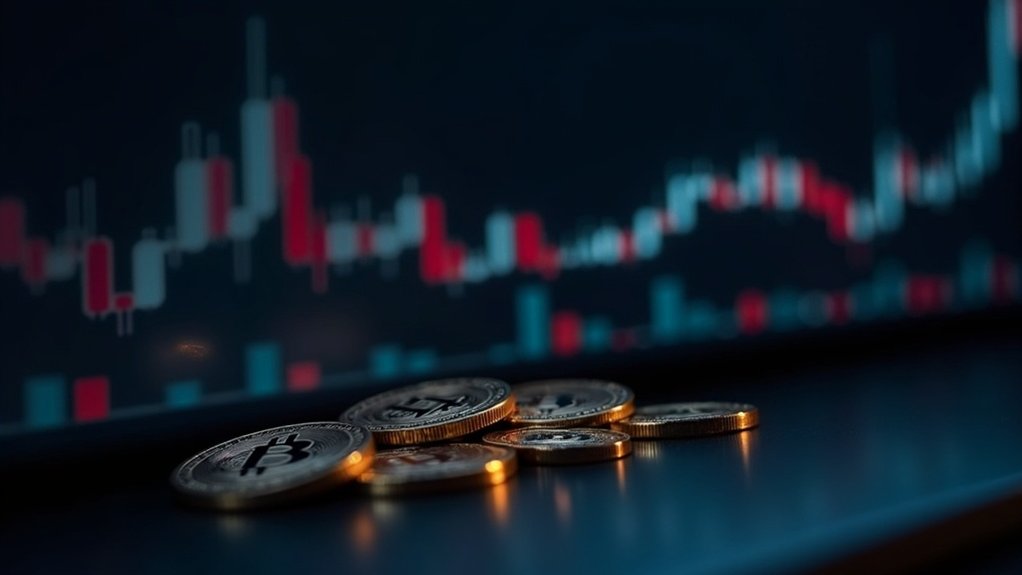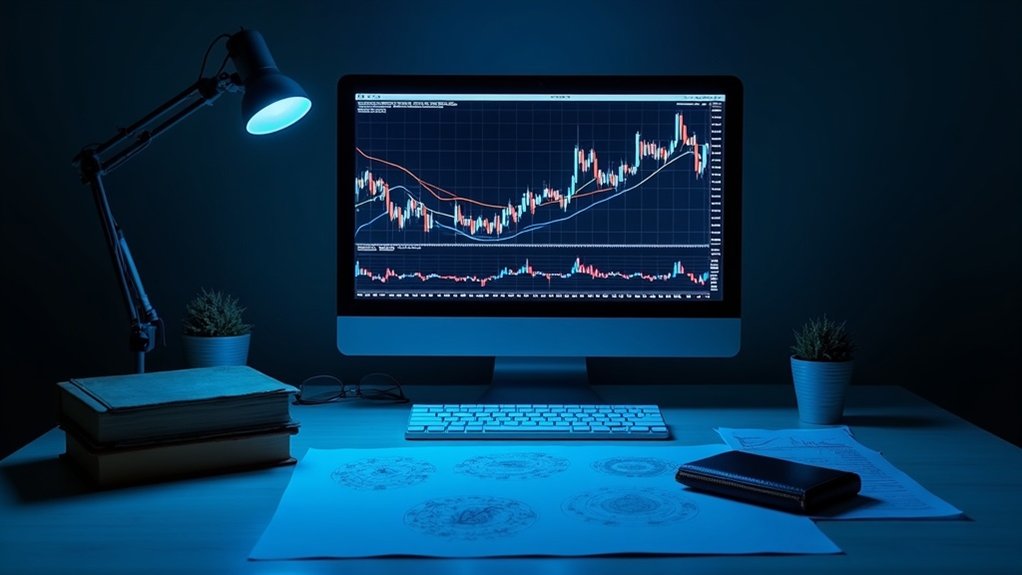The Crypto Fear and Greed Index tracks market sentiment on a 0-100 scale, capturing the collective mood of Bitcoin investors. Extreme fear (0-24) might signal buying opportunities, while extreme greed (75-100) suggests potential overvaluation. It’s calculated using volatility (25%), momentum (25%), social media (15%), and other factors. Critics say it oversimplifies things. Remember, it’s just a mood ring for the market, not a crystal ball. The real value lies beneath these emotional numbers.
While traditional markets rely on complex economic indicators, the crypto world has its own emotional barometer—the Crypto Fear and Greed Index. This daily sentiment scorecard distills the market’s collective mood into one number from 0 to 100. Dead simple. Extreme fear (0-24) might signal buying time. Extreme greed (75-100)? Maybe the market’s getting ahead of itself.
The index isn’t pulling numbers from thin air. It’s actually pretty methodical. Volatility accounts for 25% of the calculation—big price swings usually mean people are freaking out. Another quarter comes from market momentum and volume. When trading volume spikes and prices climb, that’s not fear—that’s people piling in, afraid to miss out.
Fear isn’t measured by gut feeling—it’s calculated by design. 25% volatility, 25% market momentum, and a clear methodology behind the madness.
Social media chatter contributes 15% to the score. Crypto Twitter going crazy with rocket emojis? That’s greed talking. Bitcoin dominance adds another 10%—when investors flee to Bitcoin from altcoins, they’re playing it safe. Fear. Google Trends rounds out the data with another 10%, tracking how many people are suddenly searching “Bitcoin price” at 3 AM. Even meme coins like Dogecoin, which uses a Scrypt-based algorithm, can influence social media sentiment during periods of high market activity.
The final 15% originally came from surveys, though these aren’t currently active. Not that it matters much—the index works fine without them.
What’s fascinating is how the index captures market psychology. When everyone’s panicking, smart money often finds opportunity. When your Uber driver starts explaining Bitcoin’s technical analysis, maybe it’s time to be cautious. The index witnessed a notable reading of 87 points on December 17, 2024, coinciding with Bitcoin’s all-time high of $108,135.
Critics say it’s oversimplified. They’re not wrong. But that’s kind of the point. In a market driven as much by emotion as fundamentals, sometimes you need a reality check.
The index doesn’t predict the future. It’s just a snapshot of the present mood. Use it as one tool among many. The crypto market will still be unpredictable, irrational, and occasionally brutal. That much never changes. Remember that the index is primarily Bitcoin-based despite being used to gauge sentiment for the entire cryptocurrency market.
Frequently Asked Questions
How Often Is the Crypto Fear and Greed Index Updated?
The Crypto Fear and Greed Index typically updates every 12 hours. That’s twice daily for those keeping score.
Some platforms go overboard with 15-minute updates—talk about information overload! Each refresh recalculates using fresh data on volatility, trading volume, social media sentiment, and Bitcoin dominance.
Alternate.me is the main provider, while other services offer varying update schedules. The bi-daily standard strikes a balance between capturing sentiment shifts without drowning in market noise.
Can the Index Predict Market Crashes With Accuracy?
No, the Crypto Fear and Greed Index can’t accurately predict market crashes.
It’s more like a mood ring than a crystal ball. While extreme greed readings often precede corrections and extreme fear can signal potential bottoms, timing remains elusive.
The index lacks essential factors like macroeconomics and regulatory changes.
History shows correlation with major events like the 2021 crash and 2017 bubble, but correlation isn’t causation.
It’s just one tool, not a crash prophet.
How Do Institutional Investors Use the Index in Their Strategies?
Institutional investors leverage the Fear and Greed Index as a contrarian tool. They buy during Extreme Fear when assets are undervalued and reduce exposure during Extreme Greed. Smart money, right?
They plug the index into algorithmic models to optimize entry/exit points and adjust position sizes accordingly. During fear phases, they might shift from risky altcoins to Bitcoin.
The index also helps them avoid emotional trading traps that plague retail investors. Pretty calculated stuff.
Is the Index Equally Reliable for All Cryptocurrencies?
No, the index isn’t equally reliable across all cryptocurrencies. It’s mostly Bitcoin-centric. Period.
The original CFGI was built around Bitcoin metrics – its dominance, volatility, and social media presence.
Altcoins? They’re the awkward cousins at this party. Smaller tokens suffer from less liquidity, making their sentiment signals jumpy and unreliable.
Sure, CFGI.io tries to cover 50+ tokens with fancy whale-tracking tools, but the reality?
Bitcoin still gets the VIP treatment in sentiment analysis.
What Are Alternative Sentiment Indicators Besides the Fear and Greed Index?
Alternative crypto sentiment indicators include social media analysis through platforms like LunarCrush, which tracks public mood on Twitter and Reddit.
On-chain metrics reveal actual blockchain behavior—whale movements don’t lie. Google Trends shows what people are searching (spoiler: they google “bitcoin” when prices pump).
Derivatives data like funding rates expose market biases. Each offers a different lens.
Smart investors use multiple indicators—relying on just one is asking for trouble.









